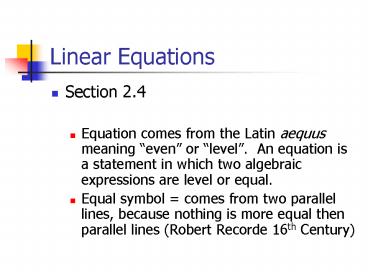Linear Equations - PowerPoint PPT Presentation
1 / 15
Title:
Linear Equations
Description:
Linear Equations. Section 2.4. Equation comes from the Latin aequus meaning 'even' or 'level' ... Solving a Linear Equation. Estimate solution as midpoint of ... – PowerPoint PPT presentation
Number of Views:593
Avg rating:3.0/5.0
Title: Linear Equations
1
Linear Equations
- Section 2.4
- Equation comes from the Latin aequus meaning
even or level. An equation is a statement in
which two algebraic expressions are level or
equal. - Equal symbol comes from two parallel lines,
because nothing is more equal then parallel lines
(Robert Recorde 16th Century)
2
Model Sociology
- The percentage of the total population in college
was 15 in 1940 and 27.5 in 1950. Since 1940
the percentage in college has increased at a
study rate of 1.25 per year. - In 1980 what was the percent of the population in
college? - In what year was the percent of the population in
college 33?
3
Decal Heuristic to Find Model
- Describe the Problem
- What is the setting?
- Solution General rate problem
- Total rate x time base amount
- What is the question?
- Solution Unknowns are year t and percent
attending college p. - Find a model for p in terms of t so we can find
the percent of the population in college in 1980
4
Decal Heuristic to Find Model
- Describe the Problem
- What are the Facts?
- Solution p 15 in 1940.
- Let 1940 be t 0, then the base amount is p
15. - Rate of increase is 1.25 per year
- What are the Distractors?
- Do not need the information about 27.5 college
attending in 1950.
5
Decal Heuristic to Find Model
- Explore Create a model using the facts and the
known relationship - Create Model
- Model p(t) 1.25 t 15
- Apply the Model What is p when t is the year
1980? - Substitute t 1980 1940 40 into the model
for the independent variable t
6
Substitution for Independent Variable
- When substituting for the independent variable in
a model, all we need is arithmetic to find the
answer. - P(40) 1.25 (40) 15
- P(40) 65 percent in college
7
Substitution for Dependent Variable
- When substituting for the dependent variable in a
model, we need methods for solving a linear
equation. - 33 1.25 t 15
8
Algebraic Method ofSolving a Linear Equation
- Use the properties of equality (pg 302) to
isolate the variable. - 33 1.25 t 15
- 33 - 15 1.25 t 15 15
- 18 1.25 t
- 18/1.25 1.25/1.25 t
- t 14.4 years after 1940
9
Algebraic Method ofSolving a Linear Equation
- Use the Algebraic Method to solve the following
equations - 7x3 8
- Multiple occurrence of variable
- 3(4x - 2) 7 5(x1)
- Non-linear reducible to linear form
10
Numeric Method ofSolving a Linear Equation
- Create a Related Function for the equation
- Set the equation equal to zero
- 33 1.25 t 15
- 1.25 t 18 0
- Substitute for zero with y to get a function of
two variables - y 1.25 t 18
11
Numeric Method ofSolving a Linear Equation
- Create a Table using the related function
- y 1.25 t 18
- Over what interval does the related function
cross the x-axis? - How does this relate to the original problem?
- Solution The y values in the table change signs
on (10,20) so there is a solution on this interval
12
Numeric Method ofSolving a Linear Equation
- Estimate solution as midpoint of interval t 15.
- Maximum error in approximation is no more than
the interval width of 10. - Zoom-in on solution interval to get a better
approximation
13
Zoom-in on Table
- Zoom-in by scale of 10 until you reach an error
of no more than 0.01. - Use Derive or Graphing Calculator to make tables.
- Solution Solution is on interval (14, 15).
Estimate as 14.5 with error of no more than 1
14
Graphic Method ofSolving a Linear Equation
- Parallels the numeric method used with tables.
- Plot the related equation y 1.25x - 18.
- Approximate the x-intercept from the graph.
- Zoom-in to get more accurate solutions error is
no more than the x-axis scale of the graph - Use technology to approximate the solution for
the College Problem.
15
Graphic Method ofSolving a Linear Equation
- What is an approximation of the year using the
graph? - Solution t14
- What is the maximum error in this approximation?
- Error is no more than 4 since the x-scale is 4































